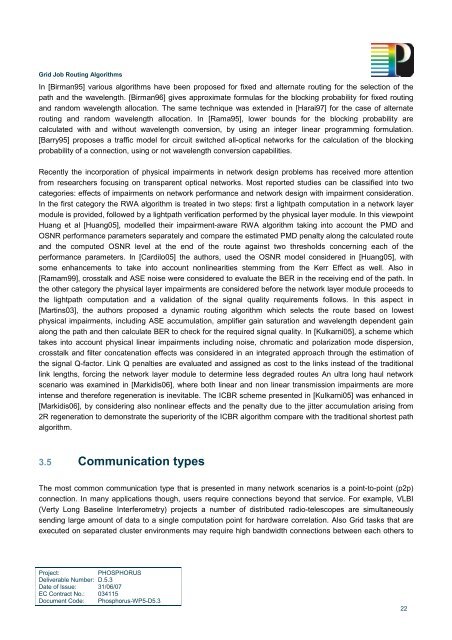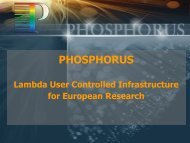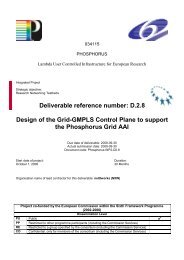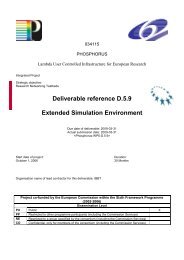Grid Job Routing Algorithms - Phosphorus
Grid Job Routing Algorithms - Phosphorus
Grid Job Routing Algorithms - Phosphorus
Create successful ePaper yourself
Turn your PDF publications into a flip-book with our unique Google optimized e-Paper software.
<strong>Grid</strong> <strong>Job</strong> <strong>Routing</strong> <strong>Algorithms</strong>In [Birman95] various algorithms have been proposed for fixed and alternate routing for the selection of thepath and the wavelength. [Birman96] gives approximate formulas for the blocking probability for fixed routingand random wavelength allocation. The same technique was extended in [Harai97] for the case of alternaterouting and random wavelength allocation. In [Rama95], lower bounds for the blocking probability arecalculated with and without wavelength conversion, by using an integer linear programming formulation.[Barry95] proposes a traffic model for circuit switched all-optical networks for the calculation of the blockingprobability of a connection, using or not wavelength conversion capabilities.Recently the incorporation of physical impairments in network design problems has received more attentionfrom researchers focusing on transparent optical networks. Most reported studies can be classified into twocategories: effects of impairments on network performance and network design with impairment consideration.In the first category the RWA algorithm is treated in two steps: first a lightpath computation in a network layermodule is provided, followed by a lightpath verification performed by the physical layer module. In this viewpointHuang et al [Huang05], modelled their impairment-aware RWA algorithm taking into account the PMD andOSNR performance parameters separately and compare the estimated PMD penalty along the calculated routeand the computed OSNR level at the end of the route against two thresholds concerning each of theperformance parameters. In [Cardilo05] the authors, used the OSNR model considered in [Huang05], withsome enhancements to take into account nonlinearities stemming from the Kerr Effect as well. Also in[Ramam99], crosstalk and ASE noise were considered to evaluate the BER in the receiving end of the path. Inthe other category the physical layer impairments are considered before the network layer module proceeds tothe lightpath computation and a validation of the signal quality requirements follows. In this aspect in[Martins03], the authors proposed a dynamic routing algorithm which selects the route based on lowestphysical impairments, including ASE accumulation, amplifier gain saturation and wavelength dependent gainalong the path and then calculate BER to check for the required signal quality. In [Kulkarni05], a scheme whichtakes into account physical linear impairments including noise, chromatic and polarization mode dispersion,crosstalk and filter concatenation effects was considered in an integrated approach through the estimation ofthe signal Q-factor. Link Q penalties are evaluated and assigned as cost to the links instead of the traditionallink lengths, forcing the network layer module to determine less degraded routes An ultra long haul networkscenario was examined in [Markidis06], where both linear and non linear transmission impairments are moreintense and therefore regeneration is inevitable. The ICBR scheme presented in [Kulkarni05] was enhanced in[Markidis06], by considering also nonlinear effects and the penalty due to the jitter accumulation arising from2R regeneration to demonstrate the superiority of the ICBR algorithm compare with the traditional shortest pathalgorithm.3.5 Communication typesThe most common communication type that is presented in many network scenarios is a point-to-point (p2p)connection. In many applications though, users require connections beyond that service. For example, VLBI(Verty Long Baseline Interferometry) projects a number of distributed radio-telescopes are simultaneouslysending large amount of data to a single computation point for hardware correlation. Also <strong>Grid</strong> tasks that areexecuted on separated cluster environments may require high bandwidth connections between each others toProject:PHOSPHORUSDeliverable Number: D.5.3Date of Issue: 31/06/07EC Contract No.: 034115Document Code: <strong>Phosphorus</strong>-WP5-D5.322






